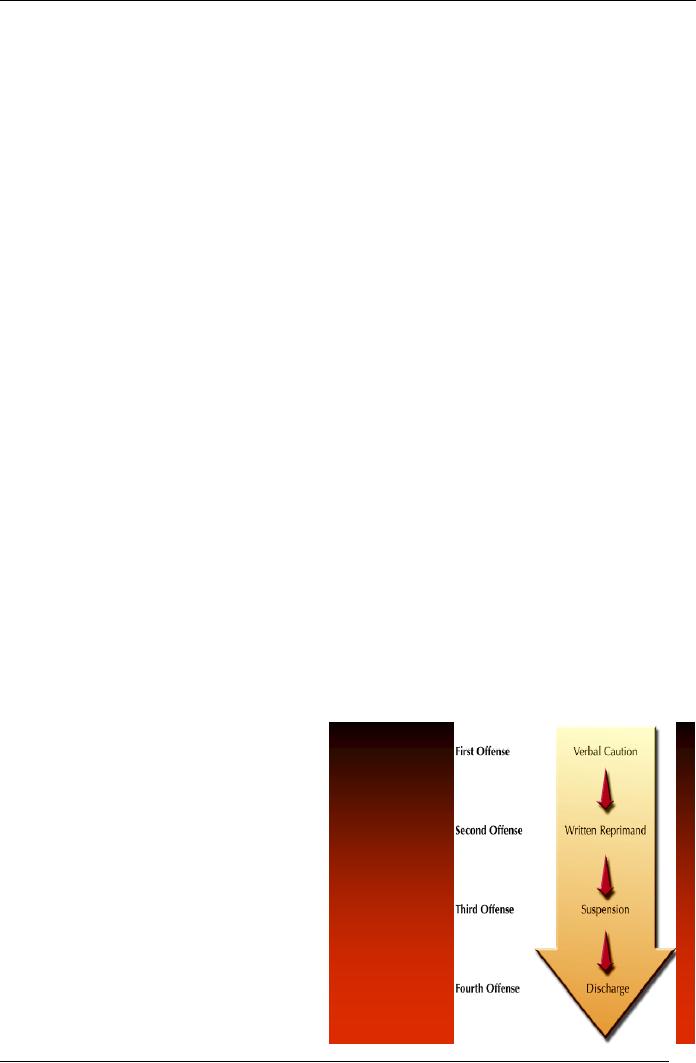 |

Human
Resource Management
(MGT501)
VU
Lesson
39
DISCIPLINE
(CONT...)
A.
Employee Separations
A.
Discipline
As
discussed in previous lectures, the term discipline
refers to a condition in the organization
where
employees
conduct themselves in accordance with the
organization's rules and standards of
acceptable. For
the
most part employees discipline
themselves by conforming to what is
considered proper
behavior
because
they believe it is the reasonable thing to
do. One they are made aware
of what is expected of them,
and
assuming they find these
standards or rules to be reasonable, they
seek to meet those
expectations. But
not
all employees will accept
the responsibility of self-discipline. There are
some employees that
will
accept
the norms of responsible employees'
behavior. These employees, then, require
some degree of
extrinsic
disciplinary action. It is this need to impose
extrinsic disciplinary action that we will
address in the
following
sections.
I.
Discipline System Recommended by Labor
Department
A
fair discipline process is based on
three prerequisites: rules
and regulations, a system of
progressive
penalties,
and an appeals process.
Inform employees ahead of time as to what
is and is not
acceptable
behavior.
Progressive penalties range
from oral warnings to
written warnings to suspension
from the job to
discharge;
the severity is a function of the
severity of the offense and, in
some cases, the number of
times
the
offense has occurred.
Discipline guidelines include the need to
determine whether there was
"just
cause"
for disciplinary action by (1) using
discipline in line with the way
management usually responds
to
similar
incidents; (2) warning the employee of
the consequences of the alleged
misconduct; (3) punishing
for
violation
of rules that are "reasonably
related" to the efficient and
safe operation of the work
environment;
(4)
investigating adequately; (5) applying
rules and employee's past
history. Fairness is built
into the system
of
discipline without punishment in that the
punitive nature of discipline is reduced
while there is an
attempt
to gain the employee's acceptance of the
rules.
II.
Factors to Consider when
Disciplining
Before
we review disciplinary guidelines, we should take at
the major factors that need to be
considered if
we
are to have fair and
equitable disciplinary practices. The
following seven contingency factors
can help us
analyze
a discipline problem:
1.
Seriousness
of the problem. How
sever is the problem? As noted
previously, dishonesty is
usually
considered
a more serious infraction
than reporting to work 20
minutes late.
2.
Duration
of problem. Have
there been other discipline
problems in the past, and
over how long a
time
span? The violation dies
not take place in a vacuum.
A first occurrence is usually
viewed
differently
than a third or fourth
offense.
3.
Frequency
and mature of the problem. Is the current
problems part of an emerging
or
continuing
pattern of disciplinary infractions? We are continual
with not only the duration
but also
the
pattern of the problem. Continual
infractions may require but
also the pattern of the problem.
Continual
infractions may require a different type
of discipline from that applied to
isolated
instances
of misconduct. They may also
point out a situation that
demands far more
sever
discipline
in order to prevent a minor
problem demands far more
severe discipline in order to
prevent
a minor problem from
becoming a major one.
4.
Extenuating
Factors. Are
there extenuating circumstances related
to the problem? The
student
who
fails to turn in her term paper by the
deadline because of the death of
her grandfather is likely
to
have her violation assessed
more leniently than will
her peer who missed the
deadline because he
overslept.
174

Human
Resource Management
(MGT501)
VU
5.
Degree
of socialization. To what extent
has management made an
earlier effort to educate
the
person
causing the problem about the existing
rules and procedures and the
consequences of
knowledge
that the violator holds of the organization's
standards of acceptable behavior.
In
contrast
to the previous item, the new employee is
less likely to have been
socialized to these
standards
than the 20-year veteran.
Additionally, the organization that has
formalized, written rules
governing
employee conduct is more justified in
aggressively enforcing
6.
Violations
of these rules than is the organization
whose rules are informal or
vague. History
of
the Organization's Discipline practices.
How have similar infractions
been dealt with in the
past
within
the department? Within the entire
organizations? Has there
been consistency in the
application
of discipline procedures? Equitable treatment of
employees must take
into
consideration
precedents within the unit
where the infraction occurs, as
well as previous
disciplinary
actions taken in other units
within the organization. ? Equity demands
consistency
against
some relevant benchmark.
7.
Management
Backing. If
employees decide to take
their case to a higher level in
management,
will
you have reasonable evidence
to justify your decision? Should the
employee challenge
your
disciplinary
action, it is important that you
have the data to back up the
necessity and equity of the
action
taken and that you feel
confident that management
will support your decision.
No
disciplinary
action is likely to carry much weight if
violators believe that they
can challenge and
successfully
override their manager's
decision.
How
can these seven items
help? Consider that there
are many reasons for
why we might discipline an
employee.
With little difficulty, we
could list several dozen or
more infraction that
management might
believe
require disciplinary action. For simplicity's sake, we
have classified the most
frequent violations
into
four
categories: attendance, on-the-
job behaviors, dishonesty,
and on the job
behavior.
Attendance
like: Unexcused
absence, chronic absenteeism, leaving
without permission
Work
Performance problems
can include action like not completing
work assignments,
producing
substandard products or services
not meeting established
production
requirements
Dishonesty
and Related Problems like,
Theft,
Falsifying employment application,
Willfully
damaging organizational property, Punching another
employee's time card,
Falsifying
work records
On-the-job
Behaviors like: Insubordination
,Smoking in unauthorized places,
Fighting,
Gambling,
Failure to use safety devices, Failure to
report injuries, Carelessness, Sleeping
on
the
job, Using abusive or threatening
language with supervisors,
Possession of narcotics or
alcohol,
Possession of firearms or other
weapons, Sexual
harassment,
Infractions
may be minor or serious given the
situation or the industry in which one
works. For example,
while
concealing defective work in a hand
power tool assembly
line may be viewed as minor,
the same
action
in an aerospace manufacturing plant is
more serious. Furthermore, recurrence
and severity of the
infraction
will play a role. For instance,
employees who experience
their first minor offense
might generally
expect
a minor reprimand. A second offense
might result in a more stringent
reprimand, and so forth. In
contrast,
the first occurrence of a serious
offense might mean not being
allowed to return to work, the
length
of time being dependent on the circumstances
surrounding the violation.
III.
Disciplinary Guidelines:
All
human resource managers should be
aware of disciplinary guidelines. In the
section, we will
briefly
describe
them.
a.
Make
Disciplinary Action Corrective Rather
than punitive. The objective is to
correct an
employee's
undesirable behavior. While punishment
may be a necessary means to
that end,
one
should never lose sight of the eventual
objective.
b.
Make disciplinary Action progressive.
Although the type of disciplinary action that
is
appropriate
may vary depending on the situation, it is generally
desirable for discipline to
175

Human
Resource Management
(MGT501)
VU
be
progressive. Only for the
most serious violations will
an employee be dismissed after a
first
offense. Typically, progressive
disciplinary action begins with a verbal warning
and
proceeds
through a written warning, suspension,
and, only in the most
serious cases,
dismissal.
More on this in a moment.
c.
Follow
the "Hot-stove" Rule. Administering
discipline can be viewed as analogous
to
touching
a hot stove (hence, the hot-stove
rule).84 While both are
painful to the recipient,
the
analogy goes further. When
you touch a hot stove,
you get an immediate
response; the
burn
you receive is instantaneous, leaving no
question of cause and effect. You
have ample
warning;
you know what happens if you
touch a red-hot stove, you
furthermore, the result
is
consistent: every time you
touch a hot stove, you
get the same response you
get burned.
In
all, the result is impersonal; regardless
of who you are, if you
touch a hot stove, you
will
get
burned. The comparison between
touching a hot stove and
administering discipline
should
be apparent, but let us
briefly expand on each of the
four points in the
analogy.
The
impact of a disciplinary action will be
reduced as the time between the
infraction and the
penalty's
implementation
lengthens. The more quickly
the discipline follows the offense, the
offense, the more
likely
it
is that the employee will
associate the discipline with the offense
rather than with the manager
imposing
the
discipline. As a result, kit is best
that the disciplinary process begin as
soon as possible after the
violation
is
noticed. Of course, this desire for
immediacy should not result in undue
haste. If all the facts are
not in,
managers
may invoke a temporary suspension,
pending a final decision in the
case. The manager has
an
obligation
to give advance warning prior to
initiating formal disciplinary action. This
means the employee
must
be aware of the organization's rule and
accept its standards of
behavior. Disciplinary action is
more
likely
to be interpreted as fair by employees
when there is clear warning that a given
violation will lead
to
discipline
and when it is known that
discipline will be. Fair treatment of
employees also demands
that
disciplinary
action be consistent. When rule
violations are enforced in an
inconsistent manner, the rules
lose
their
impact. Morale will decline
and employees will question the
competence of management.
Productivity
will
suffer as a result of employee insecurity
and anxiety. All employees want to
know the limits of
permissible
behavior, and they look to the
actions of their managers
for such feedback.
The
last
guideline
that flows from the hot-stove rule
is: keep the discipline impersonal.
Penalties should be
connected
with a given violation, not
with the personality of the violator.
That is, discipline should be
directed
at what employees have done,
not the employees themselves. As a,
manager, you should make
it
clear
that violation personal
judgments about the employee's character.
You are penalizing the rule
violation,
not the individual, and all
employees committing the violation
can expect to be
penalized.
Furthermore,
once the penalty has been
imposed, you as manager must
make every effort to forget
the
incident;
you should attempt to treat the employee in the
same manner as you did
prior to the infraction.
IV.
Disciplinary Actions (Progressive
discipline)
As
mentioned earlier, discipline generally follows a
typical sequence of four steps:
written verbal warning,
written
warning, suspension, and dismissal.
Let's
briefly
review these four
steps.
Progressive
a.
Written Verbal
Warning
The
mildest form of discipline is the
written
Discipline
verbal
warning. Yes, the term is correct.
A
Procedure
written,
verbal warning is a temporary record of
a
reprimand that is then placed in the
manager's
file
on the employee. This written
verbal
warning
should state the purpose, date,
and
outcome
of the interview with the
employee.
This
in fact, what differentiates the
written
verbal
warning from the verbal warning.
Because
of
the need to document this step in the
process,
the
verbal warning must be put into
writing. The
difference,
however, is that this warning
remains
in
the hands of the manager; that
is, it is not
176

Human
Resource Management
(MGT501)
VU
forwarded
to HRM for inclusion in the employee's
personnel file.
The
written verbal reprimand is best achieved
when completed in a private
and informal environment.
The
manager
should begin by clearly informing the
employee of the rule that has
been violated and the
problem
that
this infraction has caused.
For instance, if the employee
has been late several
times, the manager
would
reiterate
the organization's rule that employees
are to be at their desks by
8:00 A.M, and then
proceed to
give
specific evidence of how
violation of this rule has resulted in an
increase in workload for
others and
has
lowered departmental morale. After the
problem has been made
clear, the manager should then
allow
the
employee to respond. Is he aware of the
problem? Are there extenuating
circumstances that justify
his
behavior?
What does he plan to do
correct his behavior?
After
the employee has been given the
opportunity to make his
case, the manager must
determine if the
employee
has proposed an adequate solution to the
problem. If this has not been done, the
manager should
direct
the discussion toward helping the
employee figure out ways to
prevent the trouble from
recurring.
Once
a solution has been agreed
upon, the manager should ensure
that the employee understands
what, if
any,
follow-up action will be taken if the
problem recurs.
b.
Written Warning
The
second step in the progressive discipline
process is the written warning. In effect, it is the
first formal
stage
of the disciplinary procedure. This is
because the written warning becomes
part of the employee's
official
personnel file. This is achieved by
not only giving the warning to the
employee but sending a
copy
to
HRM to be inserted in the employee's
permanent record. In all
other ways, however, the
procedure
concerning
the writing of the warning is the same as the
written verbal warning; that is, the
employee is
advised
in private of the violation, its
effects, and potential
consequences of future violations.
The only
difference
is that the discussion concludes
with the employee being told
that a formal written warning
will
be
issued. Then the manager
writes up the warning-stating the problem, the rule
that has been violated,
any
acknowledgment
by the employee to correct her
behavior, and the consequences
form a recurrence of the
deviant
behavior-and sends it to HRM.
c.
Suspension
A
suspension or layoff would be the
next disciplinary step, usually
taken only the prior steps
have been
implemented
without the desired outcome.
Exceptions-where suspension is given without
any prior verbal
or
written warning occasionally occur if the
infraction is of a serious
nature.
A
suspension may be for one
day or several weeks; disciplinary
layoffs in excess of a month are
rare. Some
organizations
skip this step completely because it can
have negative consequences
for both the company
and
the employee. From the organization's
perspective, a suspension means the
loss of the employee for
the
layoff
period. If the person has unique
skills or is a vital part of a complex
process, her loss during
the
suspension
period can severely impact
her department or the organization performance if a
suitable
replacement
cannot be located. From the employee's
standpoint, a suspension can result in
the employee
returning
in a more unpleasant and
negative frame of mind than
before the layoff.
Then
why should management consider
suspending employees as a disciplinary
measure? The answer is
that
a
short layoff is potentially a rude
awakening to problem employees. It
may convince them that
management
is serious and may move them to
accept responsibility for following the
organization's rules.
d.
Dismissal
Management's
ultimate disciplinary punishment is dismissing the
problem employee. Dismissal should
be
used
only for the most serious
offenses. Yet it may be the
only feasible alternative when an
employee's
behavior
seriously interferes with a department or
the organization's operation.
A
dismissal decision should be given long
and hard consideration. For almost
all individuals, being fired
from
a fob is an emotional trauma.
For employees who have
been with the organization for
many years'
dismissal
can make it difficult to
obtain new employment or may require the
individual to undergo extensive
retraining.
In addition, management should consider
the possibility that a dismissed
employee will take
legal
action
to fight the decision. Recent
count cases indicate that
juries are cautiously
building a list of
conditions
under
which employees may not be
lawfully discharged.
177

Human
Resource Management
(MGT501)
VU
B.
Employee Separations
I.
Employee Separations
An
employee separation occurs
when an employee ceases to be a
member of an organization. The rate
of
employee
separations in an organization (the turnover
rate) is a measure of the rate at
which employees
leave
the firm.
a.
The
Costs of Employee
Separations
There
are always costs associated
with employee separations.
The cost may be more or
less, depending on
whether
managers intend to eliminate the position
or to replace the departing employee.
Costs included in
separations
include: recruitment costs, selection
costs, training costs, and
separation costs.
1.
Recruitment
costs.
2.
Selection
costs.
3.
Training
costs.
4.
Separation
costs.
b.
The
Benefits of Employee
Separations
While
many people understand the costs of
employee separations, there
are benefits as well. Some of the
benefits
of separations include: reduced labor
costs, replacement of poor
performers, increased
innovation,
and
the opportunity for greater
diversity.
1.
Reduced
labor costs.
2.
Replacement
of poor performers.
3.
Increased
innovation.
4.
Opportunity
for greater
diversity.
II.
Types
of Employee Separations
Employee
separations can be divided
into two categories based on
who initiates the termination of
the
employment
relationship. Voluntary separations (quits
and retirements) are
initiated by the employee.
Involuntary
separations (discharges and layoffs)
are initiated by the employer.
a.
Voluntary
Separations
1.
Quits.
2.
Retirements.
b.
Involuntary
Separations
Involuntary
separations occur when
management decides to terminate its
relationship with an employee
due
to
economic necessity or a poor
fit between the employee and
the organization.
1.
Discharges.
2.
Layoffs.
3.
Downsizing
and rightsizing. A reduction in the number of people
employed by a firm
(also
known as restructuring
and
rightsizing);
essentially the reverse of a company
growing and
suggests
a one-time change in the organization and the number
of people employed
III.
Managing Early
Retirements
When
a company realizes that it
needs to downsize its scale
of operations, its first
task is to examine
alternatives
to layoffs. One of the most popular of
these methods is early
retirement.
178

Human
Resource Management
(MGT501)
VU
The
Features of Early Retirement Policies:
Early
retirement policies consist of
two
features: (a) a package of financial
incentives that make it attractive
for senior employees
to
retire
earlier than they planned and (b) an open
window that restricts
eligibility to a fairly short
period.
After the window is closed, the
incentives are no longer available to
senior employees.
Avoiding
Problems with Early Retirements:
Managing
early retirement policies
requires
careful design, implementation, and
administration. When not properly
managed, early
retirement
policies can cause a host of
problems. All managers with
senior employees should
make
certain
that they do not treat senior
employees any differently than
other employees.
IV.
Managing Layoffs
Generally,
an organization will institute a layoff
when it cannot reduce its
labor costs by any other
means.
Managers
should first try to reduce
labor costs with layoff
alternatives.
Alternatives
to Layoffs: There
are many alternative methods of reducing
labor costs that
management
should explore before deciding to conduct a layoff.
These alternatives include things
such
as early retirements, employment policies
(attrition and hiring
freeze), job redesign
(job
sharing),
pay and benefits policies
(pay freezes and cuts),
training, and other
voluntary workforce
reductions.
1.
Employment
policies.
2.
Changes
in job design.
3.
Pay
and benefits policies.
4.
Training.
5.
Nontraditional
alternatives to layoffs.
Implementing
a Layoff: A
layoff can be a traumatic event
that affects the lives of
thousands of
people,
so managers must implement the layoff
carefully. Issues that need to be
considered include
how
to notify employees, developing layoff
criteria, communicating to laid-off
employees,
coordinating
media relations, maintaining security,
and reassuring survivors of the
layoff.
1.
Notifying
employees.
2.
Developing
layoff criteria.
3.
Communicating
to laid-off employees.
4.
Coordinating
media relations.
5.
Maintaining
security.
6.
Reassuring
survivors of the layoff.
V.
Outplacement
Outplacement
is a human resource program created to
help separated employees
deal with the emotional
stress
of job loss and to provide
assistance in finding a new
job
The
Goals of Outplacement:
The
goals of outplacement reflect the
organization's need to maintain employee
productivity. The
most
important
of these goals are (1)
reducing the moral problems of employees
who will be laid off so
that they
will
remain productive; (2)
minimizing the amount of litigation
initiated by separated employees;
and (3)
assisting
separated employees in quickly
finding comparable
jobs.
Outplacement
Services: The
most common outplacement services
provided to separate
employees
are emotional support and
job-search assistance. These
services can help achieve
the
goals
of outplacement.
1.
Emotional
support.
2.
Job-search
assistance.
179

Human
Resource Management
(MGT501)
VU
VI.
The role of HR Department in employee
separations and outplacement
Cooperation
and teamwork characterize the relationship
between managers and HR staff in the
employee
separation
process. HR staff can act as
valuable advisers to managers,
particularly in the dismissal
process,
by
helping them avoid mistakes
that can lead to claims of
wrongful discharge. They can
also help protect
the
employee whose rights may be
violated by managers. Furthermore, they
may assist in the development
of
and/or selection of the contents of
voluntary severance plans or
buyouts, early retirement plans,
and
outplacement
services
KEY
TERMS
Employee
Separations
An
employee separation occurs
when an employee ceases to be a
member
of
an organization.
Downsizing
A
reduction in the number of people employed by a
firm (also known as
restructuring
and
rightsizing)
Outplacement
A
company procedure that
assists a laid-off employee in
finding
employment
elsewhere
180
Table of Contents:
- INTRODUCTION TO HRM:Growing Importance of HRM, Road Map of the Course
- ESSENTIALS OF MANAGEMENT:Concepts and Essential of Management, Manager’s Roles
- ORGANIZATION AND COMPONENTS OF ORGANIZATION:Open versus Closed Systems, The Hawthorne Studies
- PEOPLE AND THEIR BEHAVIOR:Why to work in organizations?, The Goals of Organizational Behavior
- INDIVIDUAL VS. GROUP BEHAVIOR:What Are Roles?, Problem solving Team
- PERSONNEL MANAGEMENT TO HUMAN RESOURCE MANAGEMENT:Records and Administration, Competitive Advantage
- HRM IN A CHANGING ENVIRONMENT:Productivity, New Trends at Work Place
- How organization Cultivate a Diverse Workforce, STEPS TOWARD MANAGEMENT OF DIVERSITY
- FUNCTIONS AND ENVIRONMENT OF HRM:Compensation and Benefits, Safety And Health, Interrelationships of HRM Functions
- LINE AND STAFF ASPECTS OF HRM:Authority, Line versus Staff Authority, Staff Manager
- LEGAL CONTEXT OF HR DECISIONS:Doing the Right Thing, Affirmative Action, Unintended Consequences
- HUMAN RESOURCE PLANNING (HRP):Benefits of HR Planning, Forecasting Human Resource Availability
- STRATEGIC PLANNING AND HRIS:HR’s Strategic Role, Human Resource Information System, Common HRIS Functions
- JOB ANALYSIS:Purposes of the job Analysis, Questions Job Analysis Should Answer
- JOB ANALYSIS:Methods of Collecting Job Analysis Information, Observation, Source of Data
- JOB ANALYSIS (CONTD.):SURPLUS OF EMPLOYEES FORECASTED, Diversity through Recruiting Efforts
- SOURCES OF RECRUITMENT:ALTERNATIVES TO RECRUITMENT, Quantity of the Applicants, Quality of the Applicants
- SELECTION:Initial Screening, Advantages of Successful Screening
- SELECTION TESTS:Characteristics of Properly Designed Selection Tests, Guidelines for Conducting an Interview
- SELECTION PROCESS… CONTD:Background Investigations, Physical Exam, Selecting Managers
- SOCIALIZATION:Compensation and Benefits, Team Membership, Stages in socialization Process, Training and Development Trends
- TRAINING AND DEVELOPMENT:Learning, Phases of Training, Why Transfer of Training Fails
- MAXIMIZING LEARNING:Following up on Training, Repetition, Feedback, Purposes of T & D
- CAREER MANAGEMENT:Individual career planning, Career Planning and Development Methods
- PERFORMANCE:Determinants of Job Performance, Why is performance measured?, Performance Management
- PERFORMANCE APPRAISAL:What to Evaluate, The Appraisal Interview, PROBLEMS IN PERFORMANCE APPRAISAL
- JOB EVALUATION AND PRICING:THE APPRAISAL PERIOD, Ranking method,
- COMPENSATION SYSTEM:Pay, Job Pricing, Compensation: An Overview, Compensation Surveys
- BENEFITS:Total Compensation, Discretionary Benefits (Voluntary), Workplace Flexibility
- ROLE OF MONEY IN PERFORMANCE OF EMPLOYEES:Types of Pay-for-Performance Plans, Empower Employees
- MOTIVATION:The Motivation Process, Motivational Theories, Challenges of motivating employees
- OCCUPATION, HEALTH & SAFETY:Physical Conditions, Accident Investigation, Smoking in The work place
- STRESS MANAGEMENT:Symptoms of Stress, Managing Stress,
- COMMUNICATION IN ORGANIZATION:Burnout, Social Support at Work & Home, Communication in organization, Meetings
- TRADE UNIONS:Collective Bargaining, The HRM Department in a Nonunion Setting, Phases of Labor Relations
- CONFLICT AND NEGOTIATION:Transitions in Conflict Thought, Individual Conflict Management Styles
- POWER AND POLITICS:Sources of Power, Advantages and Disadvantages of PowerPower and Politics in Context
- EMPLOYEE RIGHTS AND DISCIPLINE:Contractual Rights, Management Rights, Disciplining Employees,
- DISCIPLINE (CONT...):Factors to Consider when Disciplining, Disciplinary Guidelines, Employee Separations
- LEADERSHIP:The Leader’s Behavior, Situational Theories of Leadership, Becoming a Leader
- REVISION (LESSON 12-21):Plans, Job Specification, Human resource planning, Selection Process, Corporate Culture
- REVISION (LESSON 22-26):Training, Case Study Method, Training, Performance
- REVISION (LESSON 27-35):Classification Method, Compensation, Empowerment, Mediation
- INTERNATIONAL DIMENSIONS OF HRM:Global Corporation, Type of staff members, Approaches to Global Staffing
- CONCLUSION & REVIEW:Strategies for Gaining Competitive Advantage, High-performance Work System